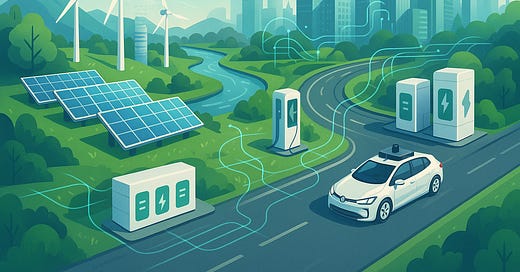Society is changing fast. Advances in software and AI have revolutionized healthcare, finance, and communication, allowing us to work smarter, act faster, and tackle previously unsolvable problems. But while software shapes much of our daily lives, it still hits limits in the physical world especially when it comes to the core systems that keep society running: our infrastructure which powers homes, transports goods and people, and delivers essentials like clean water and energy. To build a resilient and sustainable future, we need to rethink how we build and finance these foundational systems.
We are witnessing perhaps the largest investment in global infrastructure in human history, driven by urgent climate action, rapid electrification of transport and heating, and explosive growth in AI-driven data centers. At the same time, global shift towards re-industrialization and localizing industries are adding pressure for new infrastructure. All this occurs as infrastructure assets themselves become smarter, integrating software directly into hardware to enable more efficient and scalable solutions.
It is therefore not surprising that we see many strong founders stepping up to meet this demand by building what we call internally Infrastructure Technology companies, or InfraTech. These firms are using new infrastructure technologies that are proven enough to be commercialized (TRL >6). Some even source best-in-class third-party technologies and focus more on the deployment and operation of the assets.These companies span across a wide range of industries, such as energy storage (e.g. Field, Terralayr, CoPower), industrial decarbonization (e.g. Heliotec, Epyr), new forms of data centers (e.g. Evroc), direct air capture (e.g. Sirona), or autonomous fleets (e.g. Einride).
Despite this encouraging trend, young companies building these new platforms face funding challenges. Traditional venture capital (VC) and infrastructure investment operate at opposite ends of the risk-return and time spectrum.
VCs tend to back tech development with binary outlier return potential, thereby often focusing on highly scalable software or deeptech / R&D ideas with breakout character.
Meanwhile, infrastructure investors aim to deploy large amounts of capital, often billions but avoid technical or operational uncertainty. They prefer proven, reliable assets with stable cash flows and low tech risk. Most infrastructure investors also prefer centralized assets with only little operational components, while InfraTech founders are often building decentralized and smart platforms. For example, consider the shift in investment: from funding large coal-fired power plants to supporting networks of behind-the-meter battery systems.
Yet, we believe that under certain conditions, InfraTech can indeed deliver significant returns potential:
Highly scalable technologies: repeatable, standardized, and scalable deployments
Operational leverage: platforms that efficiently manage assets and optimise utilization rates often through AI enabled steering and network effects between distributed assets
Optimising for an asset-light capital structure: leveraging small-scale SPVs, dynamic credit lines and offtake agreements to minimize upfront capital requirements
Through these dynamics InfraTech is approaching a clear inflection point. With targeted funding strategies and experienced founders addressing critical societal challenges, we may soon see the emergence of a compelling new asset class that combines the ambition and innovation of venture capital with the stability and scale of infrastructure.
We are currently conducting a deep dive into the InfraTech space, speaking with a wide range of companies and investors, and mapping best practices for operations and funding journeys.
In the meantime, we’d love to hear your view on InfraTech as a new asset class. Please reach out if you’re planning to build or to invest in the space. henrik@revent.vc






